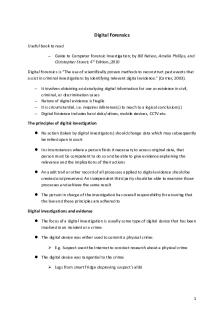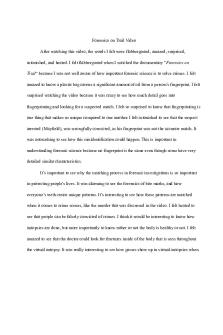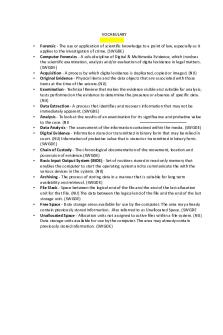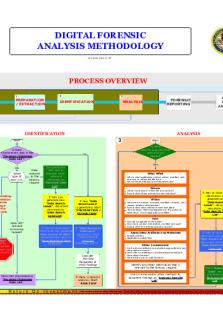Chapter 1-11 forensics PDF

| Title | Chapter 1-11 forensics |
|---|---|
| Author | Joseph Santos |
| Course | Forensic Psychology |
| Institution | The University of Western Ontario |
| Pages | 39 |
| File Size | 1.1 MB |
| File Type | |
| Total Downloads | 93 |
| Total Views | 177 |
Summary
forensic psychology notes for chapters 1 through 11...
Description
FORENSICS CHAPTER 1 – INTRO Definition: • In its broadest definition, forensic science is the application of science to criminal and civil laws. • The subject matter of this book emphasizes the application of science to those criminal and civil laws that are enforced by police agencies in a criminal justice system. • Forensic science owes its origins to individuals such as Bertillon, Galton, Lattes, Goddard, Osborn, and Locard, who developed the principles and techniques needed to identify or compare physical evidence. History: • Mathieu Orfila § The father of forensic toxicology. • Alphonse Bertillion § Devised the first scientific system of personal identification in 1879.
FIGURE 1–3 Bertillon’s system of bodily measurements as used for the identification of an individual. Sirchie Fingerprint Laboratories
• Francis Galton § Conducted the first definitive study of fingerprints and their classification. • Leone Lattes § Developed a procedure to determine blood type from dried bloodstains. • Calvin Goddard
§ Used a comparison microscope to determine if a particular gun fired a bullet. • Albert Osborn § Developed the fundamental principles of document examination. • Walter McCrone § Utilized microscopy and other analytical methodologies to examine evidence. • Hans Gross § Wrote the first treatise describing the application of scientific principles to the field of criminal investigation. • Edmond Locard § Incorporared Gross’ principles within a workable crime laboratory. • Locard’s Exchange Principle § States that when a criminal comes in contact with an object or person, a crosstransfer of evidence occurs. The Crime Lab • The ever increasing number of crime laboratories is partly the result of the following: § Supreme Court decisions in the 1960s responsible for police placing greater emphasis on scientifically evaluated evidence. § Crime laboratories inundated with drug specimens due to accelerated drug abuse. § The advent of DNA profiling. • The development of crime laboratories in the United States has been characterized by rapid growth accompanied by a lack of national and regional planning and coordination. • At present, approximately 411 public crime laboratories operate at various levels of government—federal, state, county, and municipal. Technical Support • The technical support provided by crime laboratories can be assigned to five basic services. § Physical Science Unit incorporates the principles of chemistry, physics, and geology to identify and compare physical evidence. § Biology Unit applies the knowledge of biological sciences in order to investigate blood samples, body fluids, hair, and fiber samples. § Firearms Unit investigates discharged bullets, cartridge cases, shotgun shells, and ammunition. § Document Unit provides the skills needed for handwriting analysis and other questioned-document issues. § Photographic Unit applies specialized photographic techniques for recording and examining physical evidence. Some crime laboratories may offer a number of optional services. • Optional Services by Full-Service Labs
§ § § § §
Toxicology Unit examines body fluids and organs for the presence of drugs and poisons. Latent Fingerprint Unit processes and examines evidence for latent fingerprints. Polygraph Unit conducts polygraph or lie detector tests. Voiceprint Analysis Unit attempts to tie a recorded voice to a particular suspect. Evidence-Collection Unit dispatches specially trained personnel to the crime scene to collect and preserve physical evidence.
Analyzing Physical Evidence Requires Utilizing the Scientific Method • The Scientific Method: § Formulate a question worthy of investigation. § Formulate a reasonable hypothesis to answer the question. § Test the hypothesis through experimentation. § Upon validation of the hypothesis, it become suitable as scientific evidence. Skills of a Forensic Scientist • A forensic scientist must be skilled in applying the principles and techniques of the physical and natural sciences to the analysis of the many types of evidence that may be recovered during a criminal investigation. • A forensic scientist may also provide expert court testimony. • An expert witness is an individual whom the court determines possesses knowledge relevant to the trial that is not expected of the average person. • The expert witness is called on to evaluate evidence based on specialized training and experience that the court lacks the expertise to do. • The expert will then express an opinion as to the significance of the findings. • The necessity for the forensic scientist to appear in court has been imposed on the criminal justice system by the case of Melendez-Diaz v. Massachusetts. The Frye Standard • The Frye v. United States decision set guidelines for determining the admissibility of scientific evidence into the courtroom. • To meet the Frye standard, the evidence in question must be “generally accepted” by the scientific community. Frye Not Absolute • However, in the 1993 case of Daubert v. Merrell Dow Pharmaceutical, Inc., the U.S. Supreme Court asserted that the Frye standard is not an absolute prerequisite to the admissibility of scientific evidence. • Trial judges were said to be ultimately responsible as “gatekeepers” for the admissibility and validity of scientific evidence presented in their courts, as well as all expert testimony. The Daubert Criteria
• In Daubert, the Supreme Court offered some guidelines as to how a judge can gauge scientific evidence: 1. Whether the scientific technique or theory can be (and has been) tested. 2. Whether the technique or theory has been subject to peer review and publication. 3. The technique’s potential rate of error. 4. Existence and maintenance of standards controlling the technique’s operation. 5. Whether the scientific theory or method has attracted widespread acceptance within a relevant scientific community. Special Forensic Science Services • A number of special forensic science services are available to the law enforcement community to augment the services of the crime laboratory. • These services include forensic psychiatry, forensic odontology, computer science, and forensic engineering. • Forensic Psychiatry is an area in which the relationship between human behavior and legal proceedings is examined. • Forensic Odontology involves using teeth to provide information about the identification of victims when a body is left in an unrecognizable state; also investigates bite marks. • Forensic Engineering is concerned with failure analysis, accident reconstruction, and causes and origins of fires or explosions. • Forensic Computer Science involves the examination of digital evidence. Evidence Collection Training • Many crime laboratories have “evidence technicians,” trained by the crime lab staff, on 24-hour call for evidence collection at crime scenes. • Training ensures all pertinent evidence will be recognized and collected properly. • Where no formal training exists, familiarity can be gained through lectures, tours of the lab, and evidence collection manuals. Technical Support • Document Unit provides the skills needed for handwriting analysis and other questioned-document issues. • Photographic Unit applies specialized photographic techniques for recording and examining physical evidence. Some crime laboratories may offer a number of optional services. QUESTIONS / ANSWERS • •
6) The first forensic laboratory in the United states was created in 1923. • True 7) The United States is one of only a handful of countries in the world that have created and now maintain forensic facilities
•
•
•
• •
•
•
•
• False 8) In 1993, the US Supreme Court decided that the Frye vs United States precedent is an absolute prerequisite to the admissibility of scientific evidence • False 9) Only Individuals who have accredited professional credentials from recognized university or medical programs are allowed to testify in court as an expert witness. • False 10) Strict guidelines that ensure careful and systematic collection, organization, and analysis of information is a process known as the scientific method. • True
11) Define Forensic Science. • Forensic Science is application of science to law. 12) What was the name of the first system of personal identification? What criteria did it use to distinguish individuals? • The first system of personal identification was called anthropometry. It distinguished one individual from another based on a series of body measurements. 13) What was Francis Henry Galton’s contribution to forensic science? How did this advancement improve forensic science? • Francis Henry Galton undertook the first definitive study of fingerprints and developed a methodology of classifying them for filing. 14) Who is known as the father of “Forensic Toxicology” and why? • Mathew Orfila is known as the father of Forensic Toxicology because he published the first scientific treatise on the detection of poisons and their effect on animals, a work that established forensic toxicology as a legitimate scientific endeavour. 15) Name two contributions to Forensic Science made by Hans Gross. Why are they considered important to forensic science? • Hans Gross wrote the first treatise describing the application of scientific disciplines to the field of criminal investigation. He also introduced the forensic journal Archiv fur Kriminal Anthropologie und Kriminalistil, which still reports improved methods of scientific crime detection.
•
16) With what area of forensic investigation are Karl Landsteiner and Louis Lattes associated? • Karl Landsteiner and Louis Lattes are associated with blood typing.
•
17) Who was the first person to apply the principles of forensic science to a working crime laboratory?
• • •
Edmond Locard first applied the principles of forensic science to a working crime laboratory. 18) What is Locard’s exchange principle? Locard’s exchange principle states that when two objects come into contact with each other, a cross- transfer of evidence occurs.
•
19) With what instrument did Dr. Walter McCrone make significant contributions in forensic science? • Use of Microscope
•
20) Which unit examines and compares tool marks? • Firearms unit 21) Which examines body fluids and organs for drugs and poisons? • Toxicology unit 22) What part of the body do forensic odontologists use for identification? Why is this particularly useful? • Forensic odontologists identify victims by studying teeth. Teeth are particularly useful because they are composed of enamel, which is the hardest substance in the body. Thus teeth outlast tissues and organs as decomposition begins.
• •
CHAPTER 2 – THE CRIME SCENE Upon arrival at a crime scene the first responding police officer to a crime scene is responsible for: 1. Acquiring medical assistance for injured victims - Medical personnel avoid disturbing evidence and approach the victim by an indirect route. 2. Detaining any potential suspects or witnesses - Statements are taken from victims, witnesses, and suspects. 3. Securing the crime scene to the greatest extent possible - The boundary is sealed off, and guards are posted at the entry to the crime scene if needed. - All civilians and unauthorized personnel are excluded from the crime scene. 4. Calling for any additional personnel needs such as other officers and/or forensic investigators. - The personnel required depends upon the nature of the crime scene. Securing the Crime Scene • The boundaries of the crime scene must be secured with crime scene tape, ropes, or cones.
• The secured area should include the area where the crime took place and the surrounding area where physical evidence may be located. • Once the boundaries are secured, guards may be posted to restrict access to the crime scene. • A detailed log is kept of personnel movements in and out of the crime scene. This log includes personnel names and time of entry or exit. • Investigators should never do anything that might alter the crime scene including smoking, eating, drinking, or littering. • The search for physical evidence at a crime scene must be thorough and systematic. • The search pattern selected will normally depend on the size and locale of the scene and the number of collectors participating in the search. • For a factual, unbiased reconstruction of the crime, the investigator, relying upon his or her training and experience, must not overlook any pertinent evidence. • Physical evidence can be anything from massive objects to microscopic traces. Recording Methods • Photography, sketches, and notes are the three methods for crime-scene recording. • Ideally all three should be employed; however, as is often the case, personnel and monetary limitations may prohibit the utilization of photography at every crime site. Crime Scene Notes • Note taking begins when the investigator is contacted and requested to report to the crime scene. • The crime scene notes should begin with: • The identity of person who contacted the investigator • Time of contact and arrival at the crime scene • Preliminary case information • Personnel present on arrival and those being contacted • Notes contain a personnel log, all observations made by the investigator, and the time observations were made. • Notes are taken in a uniform layout, concurrently as the observations are made. • Notes are written in a bound notebook in blue or black ink. Digital Photography • A digital photograph is made when a light sensitive microchip captures light on each of millions of tiny picture elements, called pixels. • The light is recorded on each pixel as a specific electric charge which is read by the camera as image information which is stored as a file on a memory card. • The number of pixels is directly related to the resolution of the picture. Photographs with more pixels show increasingly good resolution, or more detail and sharpness in photographs.
• The number of pixels that a camera features is usually measured in millions of pixels, or megapixels. Digital Crime Scene Photography • Advantages of digital crime scene photography include § The ability to observe images immediately after taking them ensures important photographs are clear and show the best possible detail. § The resolution available can exceed 12 megapixels, while the maximum resolution offered by a film SLR camera is equivalent to about 5 megapixels. § Computer programs can stitch digital crime scene images together to create a 3D view of the crime scene. Crime Scene Photography • Crime scene photographs should record the area in which the crime actually took place and all adjacent areas where important acts occurred. • The most important prerequisite for photographing a crime scene is for it to be in unaltered condition. • Each crime scene should be photographed as completely as possible in a logical succession. The sequence will show the overall scene first, then work down to individual pieces of evidence that jurors in the trial can easily relate back to the larger scene • The four minimum photographs required at a crime scene are an overview photograph, a medium range photograph, a close-up photograph, and a close-up photograph with a scale. • Overview photographs of the entire scene and surrounding area, including points of exit and entry, are taken first. • Taken from the outside borders of the scene and from various angles • If the crime scene includes a body, photographs must show the body’s position and location relative to the entire scene. • Include a “visual tag,” an object recorded in multiple overview photographs, to help visually piece the scene together • Medium-range photographs show the layout of smaller significant areas of the crime scene. • Taken with evidence markers in place to show the spatial relationships between and among pieces of evidence in greater detail than the overview photographs. • Include at least one photograph of the “center” of the scene. • In violent crimes, this usually includes the site where the victim was found and the surrounding area. • Close-up photographs are taken last and show greater detail of individual objects or evidence. • Taken at a 90° angle to the object, with and without evidence markers and scales. • Scales should be placed as close to the evidence as possible without affecting it in any way.
• After the 90° photographs have been taken, photographs from other angles may be taken. • The most important close-up photographs are those depicting injuries and weapons lying near a body. • After the body is removed from the scene, the surface beneath the body should be photographed. Videotaping Crime Scenes • As with still crime scene photography, the crime scene video must include overview, medium-range, and close-up images. • A narrated crime scene video combines photography and notes. § However, it is important that only one person narrates and no side conversations are captured on the video. • Some video cameras can produce still photographs, but the quality is often poor. § Therefore, still photographs from a digital camera are still required. Surveying the Crime Scene • The Walkthrough—initial survey of the crime scene 1. Perpetrator’s point of entry and exit are located. 2. Indirect path is taken to the center of the crime scene. 3. Obvious items of evidence are located and documented. 4. The conditions of the scene are observed and recorded. • Special attention is paid to item or conditions that suggest timing of the incident or do not appear to belong. Searching the Crime Scene • Line/Strip Search Pattern § One or two investigators start at the boundary of the crime scene and search in straight lines across to the other side of the crime scene. • Grid Search Pattern § Two or more investigators form a grid by searching in line patterns that overlap and are perpendicular to each other. • Spiral Search Pattern § One investigators searches in a spiral path from the center of the crime scene to the boundary (outward) or from the boundary of the crime scene to the center (inward). • Wheel/Ray Search Pattern § Several investigators search in straight lines from the center to the boundary (outward) or from the boundary to the center (inward). • Quadrant/Zone Search Pattern § The crime scene is divided into smaller sections (zones). One or more investigators are assigned to search each zone.
• Vehicle Searches § Investigators search interior and exterior of vehicle. § The vehicle may be searched at the crime scene or at the police department or crime laboratory garage. Sketching the Crime Scene • Crime scene sketches § Clearly show the layout of a crime scene § Illustrate the relationship in space of all significant items and features § Clarify objects and features already described in notes or shown in photographs. § Show measurements over long distances and topography of outdoor scenes § Depict possible paths of entry, exit, and movement through the scene The Rough Crime Scene Sketch • A rough sketch is created at the crime scene and contains an accurate depiction of the dimensions of the scene and shows the location of all pertinent objects and features. • All rough sketches include § Title block with information on the case, crime scene, and person creating the sketch § Legend with identity and dimensions of objects in the sketch § Compass showing the North direction § Body containing the sketch itself • Points of reference for objects can be shown by the distance measurements from two fixed points.
The Finished Crime Scene Sketch • The finished sketch is created from the information in rough sketch, but it is drawn to scale with care and concern for appearance. • The current standard method utilizes Computer-Aided Drafting (CAD) programs to create the finished sketch. • CAD programs also allow for the creation of three-dimensional finished sketches.
Procedures for Collection • Often, many items of evidence are clearly visible but others may be detected only through examination at the crime laboratory...
Similar Free PDFs

Forensics Chapter 1
- 5 Pages

Chapter 1-11 forensics
- 39 Pages

111 - Mindtap - Chapter 1
- 2 Pages

111 - Mindtap - Chapter 1
- 1 Pages

- BN - Forensics
- 1 Pages

BIO 111 Chapter 4 QUIZ
- 4 Pages

BMAN 111 (Eng) - Bman 111
- 33 Pages

Forensics Crash Course
- 1 Pages

Forensics Welcome Intrusion
- 1 Pages

Digital Forensics Reports
- 4 Pages

Digital Forensics Intro
- 9 Pages

Forensics on Trail Video
- 2 Pages

Digital Forensics Vocabulary
- 1 Pages
Popular Institutions
- Tinajero National High School - Annex
- Politeknik Caltex Riau
- Yokohama City University
- SGT University
- University of Al-Qadisiyah
- Divine Word College of Vigan
- Techniek College Rotterdam
- Universidade de Santiago
- Universiti Teknologi MARA Cawangan Johor Kampus Pasir Gudang
- Poltekkes Kemenkes Yogyakarta
- Baguio City National High School
- Colegio san marcos
- preparatoria uno
- Centro de Bachillerato Tecnológico Industrial y de Servicios No. 107
- Dalian Maritime University
- Quang Trung Secondary School
- Colegio Tecnológico en Informática
- Corporación Regional de Educación Superior
- Grupo CEDVA
- Dar Al Uloom University
- Centro de Estudios Preuniversitarios de la Universidad Nacional de Ingeniería
- 上智大学
- Aakash International School, Nuna Majara
- San Felipe Neri Catholic School
- Kang Chiao International School - New Taipei City
- Misamis Occidental National High School
- Institución Educativa Escuela Normal Juan Ladrilleros
- Kolehiyo ng Pantukan
- Batanes State College
- Instituto Continental
- Sekolah Menengah Kejuruan Kesehatan Kaltara (Tarakan)
- Colegio de La Inmaculada Concepcion - Cebu


